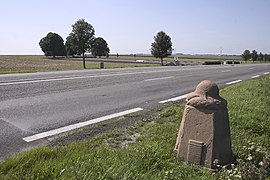Monchy-le-Preux
Monchy-le-Preux | |
|---|---|
 Stone marking the limit of the German advance in World War I | |
 Coat of arms | |
show Location of Monchy-le-Preux | |
 Monchy-le-Preux | |
| Coordinates: 50°16′14″N 2°53′39″E / 50.2706°N 2.8942°ECoordinates: 50°16′14″N 2°53′39″E / 50.2706°N 2.8942°E | |
| Country | France |
| Region | Hauts-de-France |
| Department | Pas-de-Calais |
| Arrondissement | Arras |
| Canton | Arras-2 |
| Intercommunality | Communauté urbaine d'Arras |
| Government | |
| • Mayor (2008–2014) | Michel Zéchel |
| Area 1 | 9.26 km2 (3.58 sq mi) |
| Population (Jan. 2018)[1] | 649 |
| • Density | 70/km2 (180/sq mi) |
| Time zone | UTC+01:00 (CET) |
| • Summer (DST) | UTC+02:00 (CEST) |
| INSEE/Postal code | 62582 /62118 |
| Elevation | 52–113 m (171–371 ft) (avg. 107 m or 351 ft) |
| 1 French Land Register data, which excludes lakes, ponds, glaciers > 1 km2 (0.386 sq mi or 247 acres) and river estuaries. | |
Monchy-le-Preux is a commune in the Pas-de-Calais department in the Hauts-de-France region of France.
Geography[]
Monchy-le-Preux is situated 6 miles (10 km) southeast of Arras, at the junction of the D33 and the D339 roads. Junction 15 of the A1 autoroute is just a mile away.
History[]
Monchy was an important strategic position near to Arras during the 1914-18 war and bloody fighting ensued around the village. During the Battle of Arras it was from here that the Germans bombarded Arras and destroyed the belltower. Just outside Monchy, on the D939, a carved Vauthier Stone marks the boundary of the advancing German army during the First World War.
Population[]
| Year | Pop. | ±% p.a. |
|---|---|---|
| 1968 | 465 | — |
| 1975 | 423 | −1.34% |
| 1982 | 455 | +1.05% |
| 1990 | 487 | +0.85% |
| 1999 | 521 | +0.75% |
| 2007 | 571 | +1.15% |
| 2012 | 676 | +3.43% |
| 2017 | 651 | −0.75% |
| Source: INSEE[2] | ||
Places of interest[]
- The Commonwealth War Graves Commission cemetery.
- The church of St.Martin, rebuilt along with much of the village, after World War I.
- Monchy-le-Preux (Newfoundland) Memorial commemorating the sacrifice of the soldiers of the Newfoundland Regiment on 14 April 1917.
- Two chapels.
- Remains of an old chateau.
The caribou monument to the Newfoundland Regiment
The commemorative plaque
See also[]
References[]
- ^ "Populations légales 2018". INSEE. 28 December 2020.
- ^ Population en historique depuis 1968, INSEE
External links[]
| Wikimedia Commons has media related to Monchy-le-Preux. |
Categories:
- Communes of Pas-de-Calais
- Arras arrondissement geography stubs




